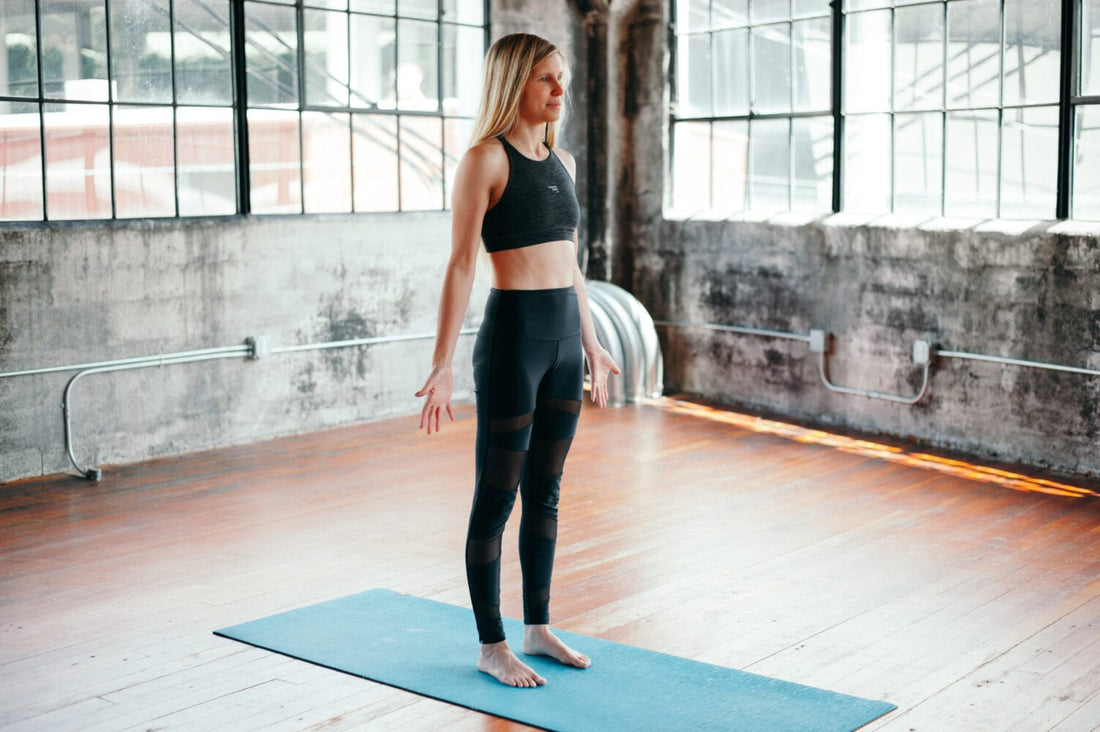Mountain Pose may just look like standing up, but with the proper engagement and posture, this simple shape can be incredibly powerful (and exhausting if done right)!
Tadasana, the Sanskrit term, is a great foundational yoga pose. It can be a resting or starting shape that you can incorporate into any practice.
Tadasana works with arms reaching high towards the sky, or extended down and slightly away from the thighs depending on where you are going.
There are a couple of terms that people use for the two versions. Some call the hands-extended-high version, Mountain Pose.
When your hands are at your sides, or hands are at heart center with palms pressing into each other, some call that Mountain, or Standing Pose, or Samasthiti. It doesn’t matter so much what it’s called. Yoga isn’t about doing it “right.” It’s just about doing it while also keeping your body safe.
Benefits of Mountain Pose
Mountain pose has a ton of benefits if you’re doing it mindfully. Who would have thought? It has the power to build a ton of strength, as well as tone the body. Just by standing there. It can improve posture, relieve sciatica, and build strength in the core, back, legs, ankles and booty.
If arms are raised, add in shoulders, arms, and neck to that list of strengtheners.
When tadasana is practiced regularly and properly, it can improve digestion. It can create space in the body to improve the respiratory system and blood circulation. It can also improve your posture which might relieve back pain, slumped shoulders, and any other posture-related discomforts.
This is a great foundational pose because it prepares the body, physically and energetically, for the rest of a yoga class, as well as for maintain general physical health. The body learns to engage and activate in this posture, and those same principles can be carried throughout every single shape regardless of how easy or hard they are.

Step-By-Step Instructions For How To Do Tadasana
- Creating the basic shape here is easy. Standing on two feet. If that’s all you’re doing when you practice, that’s not enough to see the benefits.
- Really feel into your feet here. Sometimes rocking forward on the toes, backward on the heels, and then side to side can help ground down through the whole foot.
- We always work from the ground up no matter the shape. Engage the quads (the front part of your thighs) by squeezing them so that it feels like they are wrapping in towards midline and then up towards the hips. This will lift the kneecaps and protect the knee.
- This also gently leads to engaging the glutes. As your quads lift, your glutes naturally engage as well.
- Allow the tailbone to be heavy towards the floor. You can do this by a slight tilt forward of the pelvis. This is a very subtle tilt, not a tuck. It helps release that small arch out of the low back.
- The belly is drawing in towards the spine and then up as if tucking under the ribcage.
- Shoulders are back and down, opening the heart space just slightly.
- A gentle lift through the neck and crown of the head towards the ceiling, keeping the neck neutral with the spine.
- The bottom of your chin should be somewhat parallel to the ground.
- Hands are actively reaching towards the ground. Or maybe they’re reaching up overhead depending on the shape you’re aiming for. If they are reaching up, ensure the shoulders stay mostly down and back (i.e. not hugging up towards the ears).
Adding in some variation…
You can add all kinds of variation to this shape.
- When in mountain, I like to encourage my students to really feel into their “roots.” The roots being the feet. Our feet are so important in our yoga practice and in daily life. You can rock forwards and backward on the ball mounds of the feet and the heels of the feet. Or side to side. Feel around a little bit to find your feet.
- Arms can be high or low. You can add in a side body stretch in many ways. Two favorites are, first, reach up high, grab your right wrist with your left hand and then stretch them up and over to the left (and then do the other side). Another great side stretch is to reach up. Bend into the left elbow and allow your left hand to come down behind your neck. Use your right hand to hold the left elbow and stretch gently over to the right side.
- You can also find a nice heart opener in mountain pose with a “baby backbend.” Or that’s what I always call it. Inhale arms up towards the sky. As you exhale, bend the elbows and pull the arms back and down as you lift the chest upwards. Then inhale arms back up high.
- Another variation that I enjoy, and you might too, is to just bring your hands to heart center. If you feel safe to do so, close your eyes and just breathe. Connect with yourself. If you were moving a lot before coming into this standing pose, press your thumbs into your chest and feel your heart beating.
Mountain pose is a foundational pose for a reason. If all you do every day is stand in Tadasana the proper way for 10 minutes, you’ll be on your way to better posture, a stronger body, and possibly an elevated mood.
You can come to mountain from a forward fold, chair pose, a standing knee raise. Get creative and have fun finding ways to land in this shape.
What do you feel when you are in Mountain Pose? Comment below, I'd love to hear from you!
xx - Sam






1 comment
love that you include some variations for this yoga move!